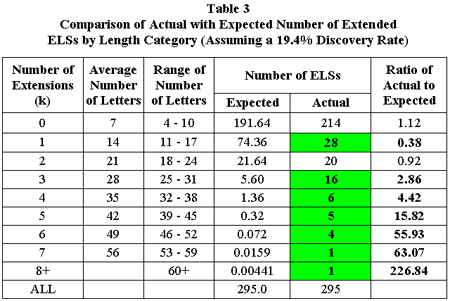| |
Non-Random Equidistant Letter
Sequence Extensions in Ezekiel
Continued
By R. Edwin Sherman, FCAS, MAAA, and Nathan Jacobi, Ph.D.
Estimating the Probability of Chance Occurrence of a Collection of
Extended ELSs as Extensive as the Ezekiel 37 Terrorist Code Cluster
In Appendix B a formula is derived for the total number of final ELSs consisting of k extensions expected to emerge from a search around n initial ELSs, given a discovery rate of d:
(1) � � � � � � � � � � � � � � � � � � � � � n ( k + 1 )dk(1 � d )2.
This formula was used to determine the expected number of lengthy ELSs for several length categories from the examination of 295 initial ELSs in Ezekiel 37 about contemporary events. Within a few days after the 9/11 terrorist attacks we selected a group of words to search for as ELSs with the shortest skips in the Tanach: Bin Laden, al Qaida, Saddam Hussein, Hussein, New York, Airliner, Tower, Terror and Suicide. We reviewed these findings in search of short sections of text where the greatest concentration of these ELSs appeared. Ezekiel 37 immediately emerged as the leading candidate. Our objective was merely to locate a solid example of potential encoding rather than to find an exasmple that optimized the improbability of chance occurrences.
The entire list of initial ELSs examined was based on key words relating to the September 11 terrorist attacks and subsequent events in the war on terror. This list evolved over time as events unfolded to target key words about current events. No initial ELSs were removed from the list for any reason.
A 19.4% discovery rate was assumed8, and the average number of Hebrew letters to be found in extensions was assumed to be 7.0 (the actual average was 7.09 in War & Peace and 6.30 in Ezekiel). Table 3 provides a comparison of the actual (vs. expected) number of lengthy ELSs in the Ezekiel 37 code cluster.

|
The actual number of extended ELSs of different lengths in Ezekiel 37 was reasonably close to expected for only two categories�those with zero and two extensions. For all other categories (shaded in green), there were statistically significant differences between actual and expected.
If the frequency of extended ELSs in Ezekiel 37 had conformed to that from War & Peace, we would expect to find 5.95 ELSs consisting of three or more extensions (and having 25 or more total letters). That is a significant number of long ELSs�an indication of the fact that the terseness of Hebrew and the absence of vowels can result in the �discovery� of some longer ELSs�even in Tolstoy�s writings.
In actuality, Dr. Jacobi found 33 ELSs in Ezekiel 37 that consisted of 25 or more letters (Appendix C)�approximately 454% more than the 5.95 expected by chance. These differences, as displayed in Table 2, are extremely significant statistically�no matter how one estimates the probability of its occurrence by chance.
Independence of the Discovery Rate to the
Number of Extensions Previously Discovered
More complex models could be constructed by assuming some relationship between d and the number of extensions that have already been discovered. The primary consideration that would need to be reflected in doing so is that the longer an ELS becomes, the more difficult it is to have the entire ELS remain coherent and continue to represent acceptable Hebrew. The previously discovered words and phrases create a context with which subsequently discovered, potentially intelligible phrases in Hebrew, need to be compatible. This effect may be somewhat offset by the possibility that when a Hebrew expert finds one extension, he may try harder to find a second extension, and so forth�since his assignment is to find longer ELSs. This concern is mitigated, at least in part, by the fact that each expert was blind as to the source text of any given letter string, and, in the case of Dr. Jacobi, was also unaware that the experiment was even taking place.
Dr. Jacobi is of the opinion that he has tended to be motivated to try harder to find yet another extension when the quality of the Hebrew in the existing extended ELS was particularly good. This was more motivating to him than the mere fact of the actual length of the extended ELS. Given that the quality of the Hebrew of an ELS tends to deteriorate as the ELS becomes longer, this would suggest that he would generally become less motivated to search for yet another extension as the existing extended ELS became longer. All of these considerations, taken together, indicate that the simple assumption of the independence of d may tend to overstate the expected number of long ELSs of different lengths from a non-encoded text.
Key Findings
Key findings from the above analysis are:- Longer ELSs can be �discovered,� even in ordinary texts, with a fair degree of frequency. This affirms the claim of code skeptics that �codes� can be found in any book.
- The extension model provides a benchmark for testing purported claims of the discovery of real Bible codes. All examples in currently published books on Bible codes fail to significantly exceed this benchmark.
- The actual number of long ELSs in Ezekiel 37 far exceeds that explainable by chance, supporting the claim that some real Bible codes do exist. The chi square p-value indicated from Table 2 is .
- If one multiplies the actual number of initial ELSs investigated in Ezekiel 37 (295) by the ratio of actual to expected ELSs in the longer categories, estimates can be obtained of the expected number of initial ELSs to have been investigated from War & Peace to find as many long ELSs as was the case with Ezekiel 37. For example, that expected number was 16,499 for ELSs of 46-52 letters, 18,605 for ELSs of 53-59 letters and 66,918 for ELSs with 60+ letters.
- The discovery rate for the first extension in Ezekiel 37 was only 14.8%. However, once at least one extension had been found, thereafter the discovery rate rose to 49.7%. Arguably, such a high discovery rate is not attainable without the presence of intentional encoding.
- One million trials were run of a simulation of the total number of ELSs with three or more extensions, given 295 initial ELSs and a discovery rate of 19.4%. The number of trials with various numbers of ELSs with 3+ extensions is shown in Table 4. The exceptionally large gap between the simulated results and the actual number of 33 ELSs in Ezekiel 37 with 3+ extensions (see graph in abstract) illustrates how infinitesimal is the probability of chance occurrence of a cluster as extensive as Ezekiel 37.

|
|
The number of trials with various numbers of ELSs with 4+ extensions is shown in Table 5 below. The exceptionally large gap between the simulated results and the actual number of 17 ELSs in Ezekiel 37 again indicates the infinitesimal probability of chance occurrence of a cluster as extensive as Ezekiel 37.

|
|
The number of trials with various numbers of ELSs with 5+ extensions is shown in Table 6 below. Again, there is a very large gap between the simulated results and the actual number of 11 ELSs in Ezekiel 37.

|
8The discovery rate corresponding to Dr. Jacobi�s searches was used�since all of the Ezekiel 37 cluster searches were performed by him.
Continue
|
Enjoy finding your own Bible codes.
Bible code search software is available in our online store.
Subscribe Free! Sign Up Today!
Become a member of the non-profit Isaac Newton Bible Code Research Society.
Not only will you be part of the world's leading organization researching and publicizing Bible and Torah codes, but you will receive Bible Code Digest absolutely free, including . . .
- Latest Bible Code News
- Easy-to-Understand Bible Code Feature Articles
- Exciting Inside Information from Leading Code Researchers
- Details of Great New Discoveries
- Summaries of the Latest Battles Between Code Proponents and Skeptics
Stay current on Bible code news. Be first to hear about all of the latest Bible code discoveries.
Sign up to receive Bible Code Digest today.
|
|







Click here
and sign up to receive Bible Code Digest with no cost or obligation.
 Code Skeptics' Arguments Trashed Ever since the first Bible codes were announced, skeptics have been saying, "Oh, well, you can also find codes like that in books like War and Peace and Moby Dick."
We took the time to examine this notion and the best example of it that the skeptics have been able to come up with. The results of our research have completely blown away their theory.
Click here to see for yourself.
NEW: Second Study Undermines
Skeptics' Main Objection
to Codes
Click here for report |











